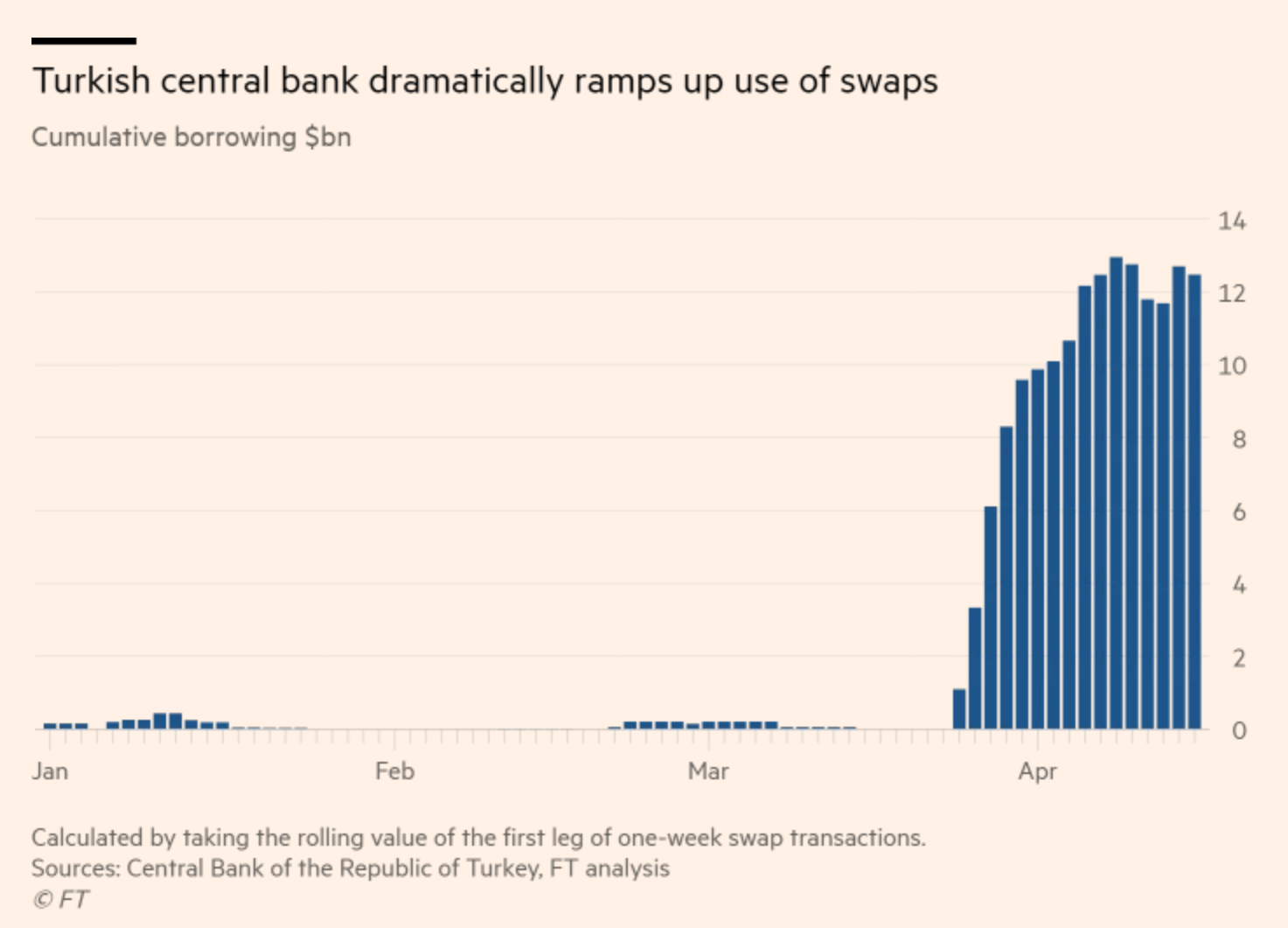It’s no secret that Turkey’s bled through their U.S. dollar reserves (aka dollar-assets) over the last 14 months as the Turkish lira’s collapsed.
And this means they’re clearly running low on ammo to defend themselves against another round of lira selling. Or to service their massive dollar-debts.
But – in case you missed it – the Central Bank of Turkey (CBT) just suddenly had a surge in U.S. dollar reserves.
Normally – this would be a good thing. But instead – it’s making analysts (and myself) very anxious.
That’s because something doesn’t quite add up. . .
Let me give you some context.
In early April, a recent report showed roughly $23 billion in foreign currency reserves ( dollar-assets) sitting on the Turkish bank’s books.
Keep in mind – most believe this is already an “inadequate” amount. Because Turkey has a constant need for U.S. dollars. (Which is needed to repay interest and principal on the massive dollar-denominated debts, defend the lira, and for foreign trade).
For perspective – Turkey has nearly $180 billion in short-term external debt. With almost all maturing over the next 12 months. . .
This is substantially more than what the Turkey has to give. (And still much more than the $77 billion in gross foreign reserves they have).
But still – this increased CBT reserve balance was far too high for what Turkey should have.
So – what gives? Where did the inflow of U.S. dollars come from?
Well – it appears that the CBT loaded up on many billions of dollars via currency swaps (short-term borrowed money) to juice up their asset reserves. . .

Remember – a currency swap (in this situation) is the practice in which the CBT exchanges liras for U.S. dollars with local banks/lenders – and promises to later reverse the transaction – aka returning the dollars.
(Also – note that swaps are short-term borrowed money that must be repaid in less than one year. Sometimes even within just a few weeks).
So – now that we know where the excess dollars came from to make the CBT’s reserves look better. How much of it must be repaid relatively soon?
According to the Financial Times – if you exclude the ’swap’ borrowed money, Turkish net-dollar assets are actually less than $11.5 billion in the month of April. (Much lower than the $23 billion the CBT states they have).

The Financial Times further added that the CBT actually “confirmed” that these short-term borrowed dollars were put on their books as an asset (currency reserves).
But the obligation to repay the borrowed dollars – which is a liability – is only added as an “off-balance sheet item”. (Meaning that the liability side of the CBT’s balance sheet doesn’t show this borrowing – even though it’s still there).
Thus – it boosts the asset-side of the balance sheet. But hides the liability-side. . .
As Potr Matys – an emerging market currency strategist for Rabobank – put it, “the use of swaps seemed to be some sort of ‘window dressing’ to create the impression of higher [dollar] reserves”.
This clearly misrepresents the CBT’s true financial health.
And the last thing the CBT – the defender of the lira –wants to do is fracture its confidence. (Which is already shaky).
Because – if that happens – the markets won’t believe the CBT next time they say they have things under control.
This all puts the CBT in a very fragile position. . .
So – what did the CBT think they were doing with this short-term borrowing (and thinking)?
It looks like they attempted to borrow short-term dollars and defend the lira during the recent Turkish elections – to give off the impression things were recovering. And prevent the lira from weakening (further raising import costs on citizens).
This is problematic – because the increase in reserves doesn’t even match the amount borrowed through the swap agreements. . .
This most likely means that much of the borrowed dollars were already used to prop up the lira.
Or – in trader speak – they ‘borrowed short, and went long’. (Aka they borrowed short-term dollars, sold those dollars, and bought lira instead – all in attempt to stabilize a weaker lira).
This indicates that the CBT will need to borrow even more dollars in the future – just to repay the maturing short-term debt (and risk suffering huge losses if the lira falls).
Again – this is a very fragile position to be in.
Especially if a single negative shock occurs – shaking up Turkey’s economy and currency. . .
So – in summary – the Central Bank of Turkey tried appealing to investors.
They did so by artificially increasing their U.S. dollar reserves with ‘off balance sheet liabilities’– such as using short-term swap agreements.
But – instead of looking robust – the CBT looks even more fragile.
Rogue economist – Hyman Minsky – called this the ‘Ponzi-stage’. (When debtors need to borrow new debt just to simply pay interest and repay maturing debt).
Thus – the next year should be a painful one for Turkey’s economy.
Especially as dollar-liquidity dries up. And investors realize the desperate ‘Ponzi’-like financing Turkey requires.
It may be time to again – as I wrote about in March 2018 – to short Turkey via long-dated, out of money, put options on the iShares MSCI Turkey (NASDAQ:TUR).
I believe the Turkish lira will continue falling over the year as investors realize the long-term risks of this short-term thinking.
